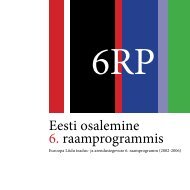Reactive Systems: Modelling, Specification and Verification - Cs.ioc.ee
Reactive Systems: Modelling, Specification and Verification - Cs.ioc.ee
Reactive Systems: Modelling, Specification and Verification - Cs.ioc.ee
You also want an ePaper? Increase the reach of your titles
YUMPU automatically turns print PDFs into web optimized ePapers that Google loves.
3.5. GAME CHARACTERIZATION OF BISIMILARITY 73<br />
- if s1 α → s ′ 1 , then there is a sequence of transitions s2 τ ⇒ s ′′<br />
2<br />
τ<br />
⇒ s ′ 2 such that s′ 1 ≈ s′ 2 ;<br />
s ′′′<br />
2<br />
- if s2 α → s ′ 2 , then there is a sequence of transitions s1 τ ⇒ s ′′<br />
1<br />
τ<br />
⇒ s ′ 1 such that s′ 1 ≈ s′ 2 .<br />
s ′′′<br />
1<br />
Prove the following claims.<br />
1. The relation ≈ c is an equivalence relation.<br />
2. The relation ≈ c is preserved by the operators of CCS—that is, show that if<br />
P ≈ c Q, then<br />
• α.P ≈ c α.Q, for each action α;<br />
• P + R ≈ c Q + R <strong>and</strong> R + P ≈ c R + Q, for each process R;<br />
• P | R ≈ c Q | R <strong>and</strong> R | P ≈ c R | Q, for each process R;<br />
• P [f] ≈ c Q[f], for each relabelling f; <strong>and</strong><br />
• P \ L ≈ c Q \ L, for each set of labels L.<br />
3. Argue that ≈ c is included in weak bisimilarity.<br />
4. Find an example of two weakly bisimilar processes that are not related with<br />
respect to ≈ c .<br />
Which of the τ-laws from Exercise 3.26 holds with respect to ≈ c ? <br />
3.5 Game characterization of bisimilarity<br />
We can naturally ask ourselves the following question:<br />
What techniques do we have to show that two states are not bisimilar?<br />
In order to prove that for two given states s <strong>and</strong> t it is the case that s ∼ t, we should<br />
by Definition 3.2 enumerate all binary relations over the set of states <strong>and</strong> for each<br />
of them show that if it contains the pair (s, t) then it is not a strong bisimulation.<br />
For the transition system from Example 3.1 on page 44 this translates into investigating<br />
225 different c<strong>and</strong>idates <strong>and</strong> in general for a transition system with n states<br />
one would have to go through 2n2 different binary relations. (Can you s<strong>ee</strong> why?)<br />
In what follows, we will introduce a game characterization of strong bisimilarity,<br />
which will enable us to determine in a much more perspicuous way whether two<br />
states are strongly bisimilar or not.<br />
The idea is that there are two players in the bisimulation game, called ‘attacker’<br />
<strong>and</strong> ‘defender’. The attacker is trying to show that two given states are not bisimilar<br />
while the defender aims to show the opposite. The formal definition follows.<br />
α<br />
→<br />
α<br />
→
















